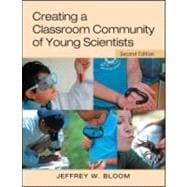
Note: Supplemental materials are not guaranteed with Rental or Used book purchases.
Purchase Benefits
Looking to rent a book? Rent Creating a Classroom Community of Young Scientists [ISBN: 9780415952361] for the semester, quarter, and short term or search our site for other textbooks by Bloom; Jeffrey. Renting a textbook can save you up to 90% from the cost of buying.
| Getting Started Introduction | |
| Beginning the journey | |
| Philosophy and theoretical framework | |
| Goals and emphases | |
| How to use this book | |
| Some questions to consider | |
| Two quotes to think about | |
| Initial Explorations | |
| Pond water investigation | |
| Investigating earthworms | |
| Nature walk | |
| Moon study | |
| Exploring light, lenses, and mirrors | |
| Summary | |
| Teaching Science for Children's Meaningful Learning | |
| Nature of Science | |
| Introduction | |
| Views of science: Scientists and thinkers about science | |
| Activities | |
| Examples of children's ideas | |
| Summary | |
| Children's Learning and Sense-Making | |
| Constructivism | |
| Social constructivism | |
| Contexts of meaning | |
| Categorization | |
| Play | |
| Complex learning | |
| Summary of implications for teaching | |
| Children's Talk | |
| The traditional approach to classroom discussions | |
| An alternative approach to classroom discussions | |
| An example of a classroom argument | |
| Extending our understandings of how to work with children's discussions | |
| Teaching and Learning through Inquiry | |
| Types of questions and inquiry | |
| Patterns of inquiry in the classroom | |
| A cycle of inquiry | |
| Observational studies | |
| Experimental studies | |
| Inquiry and learning | |
| Assessing Children's Learning, Thinking, and Talk | |
| Establishing goals | |
| Some necessary background | |
| The purpose of assessment | |
| Some approaches to assessment | |
| Observations and performance assessment | |
| What to look for and keeping track | |
| Additional issues of assessment as driven by curricular documents and national standards | |
| A final activity | |
| Planning and Implementing Instruction | |
| Some basic guidelines and principles to consider | |
| How and where to start | |
| A simple model of planning - E | p. 7 |
| Instructional plans | |
| Alternative sequencing for a restricted curriculum situation | |
| Taking into account children's ability levels (...but not selling them short!) | |
| Teaching and working with children: Implementing instruction | |
| Some example unit topics and themes | |
| Yearly planning | |
| Classroom as Community of Young Scientists | |
| Developing the classroom as a community of learners, inquirers, and young scientists | |
| Establishing a classroom community | |
| Setting up your classroom | |
| Working with children | |
| Working with parents and the extended community | |
| Working with yourself | |
| Reflective Practice | |
| Background to professional thinking and learning | |
| An overview of reflection | |
| Working with yourself | |
| The focus of reflection | |
| Reflection examples and activities | |
| Dilemmas | |
| Where to Go From Here: Participating in the Professional Community | |
| Participating in the professional community | |
| Continuing to learn about science | |
| Continuing your professional development | |
| Appendices | |
| Safety | |
| Physical safety | |
| Personal, psychological, and social safety | |
| United States Science Education Standards | |
| Canadian Science Education Standards | |
| Learning and Teaching for Complexity | |
| Systems | |
| Patterns, metapatterns, and other broadly connecting concepts | |
| Teaching and learning for complex understandings | |
| More On Planning - Curriculum Units | |
| More planning tools | |
| Sample curriculum unit ideas | |
| Field Studies | |
| Types of field studies | |
| Planning an extended field study | |
| Summary | |
| Sample Activities | |
| Structures | |
| Marble collisions | |
| Pendulums | |
| Balancing act | |
| Batteries and bulbs | |
| Construct a boat to hold a specific cargo | |
| Forest or open field study | |
| Exploring metapatterns | |
| Challengers - Jumping into what scientists experience | |
| Data Collection and Analysis Techniques | |
| Background | |
| Coll | |
| Table of Contents provided by Publisher. All Rights Reserved. |
The New copy of this book will include any supplemental materials advertised. Please check the title of the book to determine if it should include any access cards, study guides, lab manuals, CDs, etc.
The Used, Rental and eBook copies of this book are not guaranteed to include any supplemental materials. Typically, only the book itself is included. This is true even if the title states it includes any access cards, study guides, lab manuals, CDs, etc.